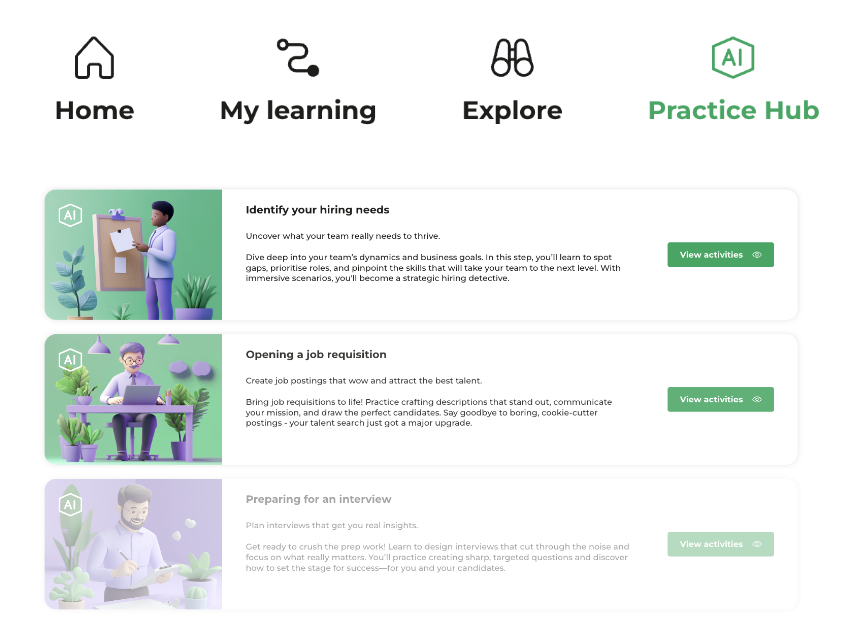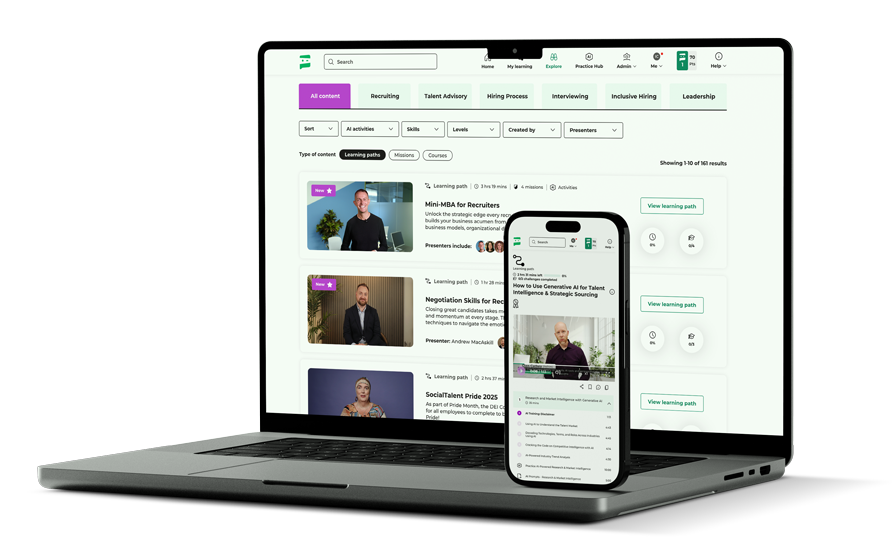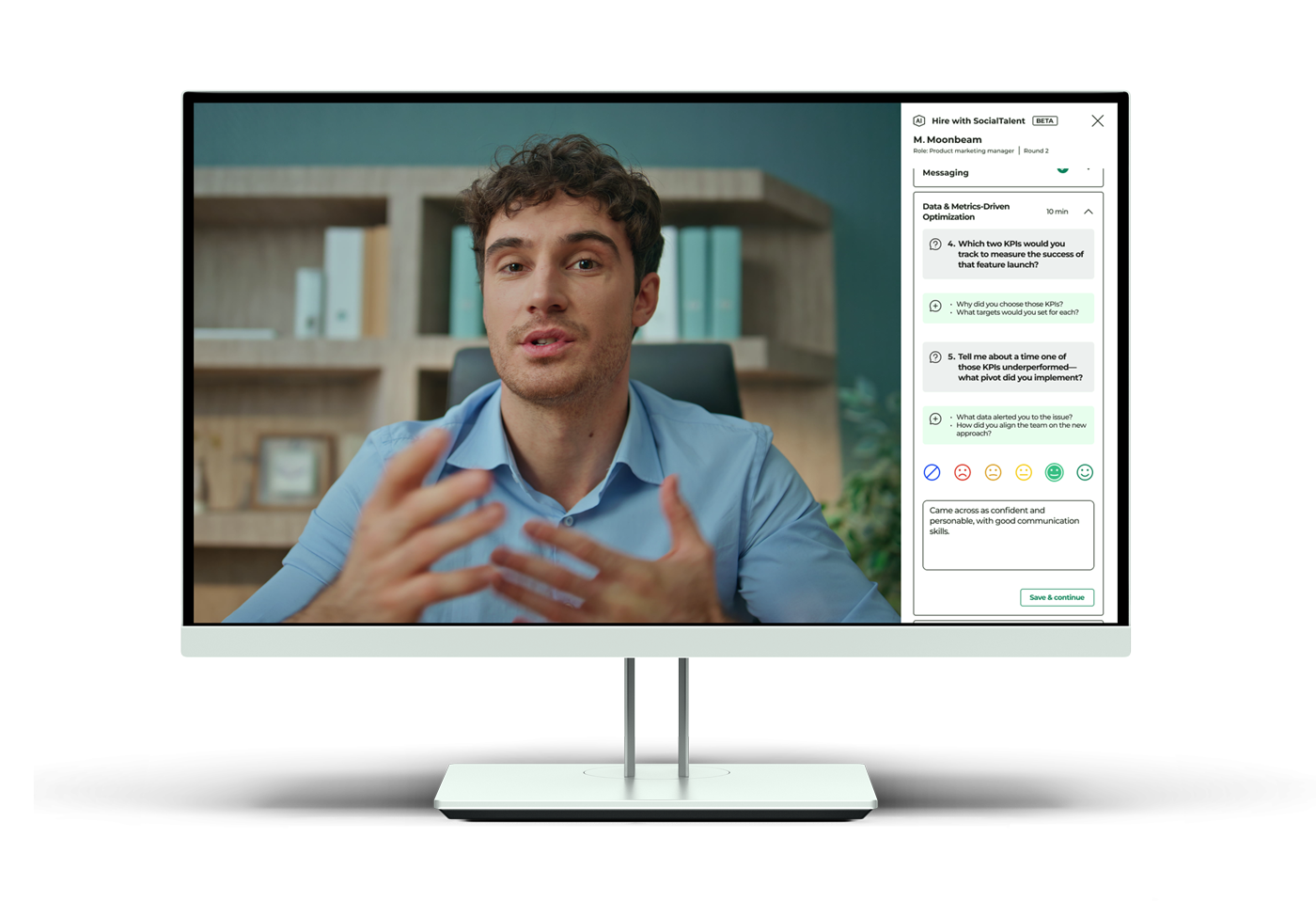
By David Deady
Hiring managers are constantly juggling priorities – from sourcing talent to conducting interviews to making tough decisions. In the chaos of everyday tasks, where’s the time to truly practice and refine those crucial hiring skills?
For most, the answer is: there isn’t.
Despite the best intentions, traditional training often falls short, leaving hiring professionals to rely on theory rather than hands-on experience.
That’s why we created SocialTalent’s Practice Hub – a game-changing new feature that empowers hiring managers and recruiters to actively build and hone their skills in real-world scenarios. No more passive learning. Just practical, relevant exercises designed to make a difference.

Moving Beyond Theory
We’ve all been there – you complete a training session, feel inspired, but when it’s time to put it into practice, you draw a blank. It’s not that the hiring training wasn’t useful – it’s just that passive learning doesn’t stick. And it’s backed up by data: Research from Indiana University of Pennsylvania indicates that active learning leads to significantly higher retention rates – with active learners remembering 93.5% of previously learned material compared to 79% for passive learners.
In hiring, where every decision can have long-term impacts, that’s a problem.
Practice Hub changes this dynamic by focusing on hands-on, interactive, AI-powered activities that empower users to learn by doing. Whether it’s crafting behavioral interview questions or planning an effective alignment meeting, Practice Hub turns theory into action, building lasting skills along the way.
Learn more: 5 Benefits of AI-Powered Learning for Recruiters
What Is Practice Hub?
Practice Hub is an interactive tool designed to help users develop and enhance their hiring skills through practical, real-world activities. Unlike traditional training modules, Practice Hub’s exercises are designed to be immediately applicable, helping users embed new skills into their daily workflow.
At its core, Practice Hub is about learning through application – enabling users to immediately apply skills in real-world hiring scenarios. And the best part? It’s AI-powered and informed by SocialTalent’s expert catalogue of hiring best practices, ensuring that every activity is rooted in proven, real-world knowledge. This combination of cutting-edge technology and expert insights makes Practice Hub a reliable and impactful way to build your skills.
Features that Make Practice Hub Unique
- AI-Powered Learning: Practice Hub leverages AI to create realistic simulations and guide users through complex hiring scenarios, making skill development more practical and impactful.
- Expert-Backed Content: Each activity is informed by SocialTalent’s extensive catalogue of expert-led training, ensuring quality and relevance.
- Interactive Learning: Practice Hub offers 19 carefully designed activities spanning the entire hiring journey. From defining hiring needs to giving candidate feedback, each activity targets a specific challenge hiring managers face every day.
- Real-World Application: Activities like the AI-Powered Interview Simulation, creating behavioral questions, and facilitating debrief meetings are directly linked to tasks hiring managers regularly perform.
- User Experience Enhancements: The interface is designed for ease of use, and upcoming updates will introduce even more recruiter-specific activities to support a wide range of hiring needs.
“Practice Hub represents a new era in hiring skill development. By combining AI-driven insights with practical, real-world exercises, we’re giving hiring managers a powerful tool to build confidence and make smarter decisions. It’s about moving beyond theory and equipping users with skills that truly stick.”
– Paula Hatch, Chief Product Officer, SocialTalent
Practical Examples: Practice in Action
Scenario 1:
Picture this: You’re about to kick off a new hiring project. Instead of winging it, you hop onto the Practice Hub to map out the team’s priorities and expectations, getting bespoke feedback and suggestions. Now, everyone’s on the same page, and you feel confident moving forward.
Scenario 2:
It’s the day before a big interview. You’ve been thinking about how to assess the candidate’s potential beyond their resume. You jump into Practice Hub’s AI-Powered “Interviewing for Learning Agility” exercise, and suddenly, you have targeted questions to gauge how the candidate adapts to new challenges.
Scenario 3:
The interview’s done, and now it’s decision time. Instead of going purely on gut feeling, you and your team run through the “Hiring Decision Reflection” activity. You identify potential biases, weigh insights fairly, and make a confident, data-driven choice that cuts through the noise.
How Practice Hub Fits into Your Workflow
Learning in the flow of work is essential for today’s busy hiring managers. SocialTalent’s Practice Hub allows users to build confidence through real practice rather than just absorbing information passively. The practical, scenario-based approach encourages quick learning without disrupting daily tasks. As HBR states:
“When teams don’t find ways to learn as they work, they limit their performance. And for organizations, an absence of learning in flow reduces their ability to respond to change and compete in the market.”
By integrating Practice Hub into your hiring process, you don’t just enhance skills – you make practice a core part of your hiring culture. Imagine your team feeling more confident, making better decisions, and consistently bringing their best to every hiring situation.
Practice Makes Perfect
Practice Hub isn’t just another training tool to add to the pile.
It’s a dynamic, interactive way to develop hiring skills, ensuring users feel prepared and confident when it matters most. Backed by SocialTalent’s expertise and AI-driven insights, it’s the practical solution hiring managers have been waiting for.
So why wait? Dive into Practice Hub today and experience how practice truly makes perfect.



